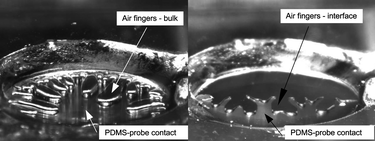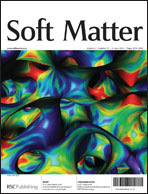We present the first quantitative measurement of the receding contact angle between a soft viscoelastic material and a solid surface during the debonding of the material. We developed a new method of observation, based on the technique pioneered by Yamaguchi et al. (T. Yamaguchi, K. Koike, and M. Doi, Euro. Phys. Lett., 2007, 77, 64002). In a probe-tack geometry, we obtained a 3D-like view of the debonding pattern as seen through the adhesive/probe interface, providing thus an excellent view of the details of the contact geometry near the interface. Combining visual and force-displacement information in a probe tack test, we identified three different categories of mechanisms and contact geometries as a function of the material parameters. For very weakly crosslinked viscoelastic materials around the gel point, air fingers form in the bulk of the layer. For higher degrees of crosslinking, the air fingers form and propagate at the interface, with a large deformation of the bulk of the layer. A well defined and reproducible receding contact angle φ < 90° depending on the viscoelastic properties of the layer was observed at the leading edge of the moving finger. Finally for well crosslinked samples the failure occurs by interfacial crack propagation with little deformation of the layer; the contact angle at the leading edge then was close to 90° as expected from elastic fracture mechanics.

You have access to this article
 Please wait while we load your content...
Something went wrong. Try again?
Please wait while we load your content...
Something went wrong. Try again?


 Please wait while we load your content...
Please wait while we load your content...